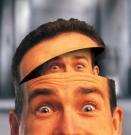Cotara Syndrome
 Cotard syndrome is a delusional hallucinatory disorder that accompanies a person in some studied states of the psyche. Cotar's syndrome in psychiatry does not occur daily, but its danger is too great not to study it with detailed considerations. This psycho-manifestation always symbolizes a serious brain problem that demonstrates dangerous manifestations in an individual.
Cotard syndrome is a delusional hallucinatory disorder that accompanies a person in some studied states of the psyche. Cotar's syndrome in psychiatry does not occur daily, but its danger is too great not to study it with detailed considerations. This psycho-manifestation always symbolizes a serious brain problem that demonstrates dangerous manifestations in an individual.
Such hallucinatory syndromes belong to perceptual disorders with secondary delirium, which means that hallucinations are formed for internal brain reasons. But the delusional aspects explain the character hallucinatory manifestations, it is a kind of protection of the psyche.
What is Cotara syndrome?
Some individuals who need adrenaline adore the horror genre, or horror genre. Here is Kotar's syndrome - this is, just about that. Uzhastiki have many branches, but one of the most popular is the living dead, that is, the zombie. This can not but be horrible, since religious roots are strong even for atheists because of the years of faith, and individuals can not help but be horrified when the deceased person does not end up dead, when his body is still moving, already soulless. It is impossible to imagine how to live an individual who imagines himself a zombie. But this is the fate of such persons. It can not be said that this is a typical picture of a zombie apocalypse, because the symptomatology can not be like a film, it is too individual for this, and introduces its edits into the personality of a person with mental disorders.
Some historical descriptions of this state have been preserved from historical data. Cotard's syndrome, which was not known at that time, was investigated at the dawn of psychiatry. It was in 1880, a little-known psychiatrist from France, in whom a lot of people were born who influenced the entire course of psychiatry of individuals, studied depressive states. It was in the future that a well-known psychiatrist and neurologist( because then these specialties did not separate, however, and now they have a contiguity) revealed this condition in his depressed patient. It was then that the term nihilistic nonsense was used, that is, nonsense. This, as it were, is the reverse side of the medal of delusional manifestations. Usually in delirium, the person thinks out what is superfluous, but not in this case. That is why this nonsense is nonsensical, some even believe that it is a prototype, a complete inversion of delusions of grandeur, when a person praises himself.
According to the ICD, delirium Kotara is able to manifest itself with several pathologies, which is why it can be under different numbers. In a new way such a formulation is not made in the diagnosis, this doctor will display in the patient's description, and in the diagnosis there will be, for example, a chronic delusional disorder under No. F 22.
Zhul Kotar did not put forward hopes as a great psychiatrist. Initially, after receiving medical knowledge, he worked in a clinic for strokes. Only much later he took up psychiatry, and then, thanks to which he is so famous, Katara's delirium, he opened nine years before his own death, already after moving from the Salpitriere hospital. He became the prototype of the character from the novel and film and was famous for his discoveries and ideal life, it was due to this disease that he received his name.
Causes of Cotard Syndrome
Cotar syndrome in psychiatry can be formed by several mechanisms, because it can be based completely antipolar pathologies. The most common cause is depressive conditions. In severe depression, endogenous with psychotic disorders, Kotara's delirium is formed, which indicates serious endogenous, neural disorders. This can no longer be designated as a depressive state, this disorder in this configuration is more reminiscent of a depressive psychosis in terms of symptoms and consequences. There is a common misconception that this depressive syndrome only has Kotar's syndrome in its structure, but such a severe nihilistic nonsense is possible even with a number of other pathologies.
Cotar syndrome in psychiatry manifests itself in many endogenous diseases, as well as with especially severe somatic and symptomatic diseases. With some rare forms of schizophrenic manifestation, as well as in post-schizophrenic depression, such a pathology is possible and allows an individual to explain his unpleasant irrational sensations. Not only schizophrenia itself, but also the schizoid disease spectrum can produce such an unfavorable effect, for example, schizoaffective disorder in the depressive phase, it combines schizophrenic disorder of thinking and mood disorder. The schizotypal disorder can also have a similar kind of concomitant pathology. In general, schizoid individuals undoubtedly have a great propensity for similar pathologies, which is associated with a slowed-down feature of thought processes, they are like cogs when one thought is thought about for a long time.
Cotar syndrome in psychiatry is also inherent in senile pathologies, in general this syndrome is more age-specific, inherent in the older generation. Senile dementia with unfavorable rapid progression may have a similar symptomatology. Undoubtedly, all these manifestations are attributed to mental abnormalities with a hard-to-manage adverse outcome. The senile dementia in persons can have different background. In some cases, it is a vascular pathology, for example, with severe atherosclerosis of cerebral vessels, in particular cerebral. With atherosclerosis, the vessel is clogged with plaques of the same name, which disrupts the blood flow and eventually leads to brain atrophy due to poor nutrition. It is then, when it is damaged, and there is such an unfavorable productive symptomatology. Vascular causes do not end there, there may also be other vascular problems, for example, diabetes mellitus gives such a complication.
Cotard syndrome is found in women more often, perhaps because it is typical for most depressed age patients, and it is still more often women. And perhaps women are more often nihilistically tuned to their body. And yet the statistics remain stable, women are more likely to appear the syndrome of Kotar.
Of neurological disorders, which are progressing more and more, Kotar syndrome can also develop. The trigger mechanism for its development can be a severe and rapidly disabling pathology - progressive paralysis.
Cotar syndrome in psychiatry can develop not only with endogenous churches, that is, having internal mechanisms incorporated in the person. It can also occur with severe reactive depression, in particular with the impact of huge stressors, which forced a person to completely change inwardly.
It is pathogenetically known that such a pathological recognition of oneself and the world around is possible due to a violation of the limbic system. Also, its role is played out by the amygdala, which is responsible for the will. Some medications can give similar symptoms, in particular, there are some data on the overdose of Acyclovir, which can lead to Kotar's syndrome, but only with the concomitant pathology of the kidneys.
Symptoms of Cotard Syndrome
This disease has its own characteristic manifestations, which are critical for its diagnosis. The main symptom of Kotar's syndrome is the eponymous nihilistic delirium of Kotar. This nonsense can have several branches of manifestations and depends on hallucinatory perception. This nonsense manifests the patient's stories about the decayed organ, and these statements are absolutely absurd and quite serious on the part of the patient. He can say that the intestines rot, food does not come, so there is not why. And drugs for him to translate is not worth it, there is no intestine. Sometimes these statements reach the need for probe feeding, as they spit out all the food, claiming they can not swallow. Sometimes patients say that they do not breathe air, that their bodies have not worked for a long time. Sometimes this nonsense is more megalomaniac and captures not only the character, but the world around, while they already believe that not only they are dead, but the whole world - it has rotted for a long time, everything has turned black and does not work. This nonsense is called hypochondriacal, because it is associated with the organs of the suffering individual. Delirium is called nihilistic, because it denies the existence of either organs, or the character himself, or even the liveliness of the world. Brad is megalomaniac, because its scale can cover the whole universe, that is, it is very vast and grandiose. Such patients always have the affect of fear, because to exist in a dying world they are very horrified, considering also the perplexities of others. The content of it is certainly fantasy, because our world, good, is not yet mired in a zombie apocalypse, and hence for such delusions there is no real underlying reason.
The main symptom of Kotar syndrome is also depression, and it is necessarily alarming, right up to agitation. Surprise is not suggestive, since a character who is aware of his death, and even of the whole world can not remain calm, he will undoubtedly be alarmed. And it is known that psychiatric disorders are experienced much more than in reality. Depression manifests itself in a decrease in mood, which can be identified by psycho-scales, as well as by mental and motor deceleration, although with agitation all this may be absent.
Another major symptom of Kotar syndrome is psychosensory disorders. In this case it is depersonalization, that is, denial of oneself or some parts, as well as derealization - a twisted perception of the world. One of the main symptoms of Kotar's syndrome is suicidality. Patients can inflict self-harm by attempting to kill themselves, because they blame themselves for the surrounding catastrophes, or simply can not tolerate depersonalization changes, realizing that they do not exist, experiencing painful psychic anesthesia.
Usually, with initial disorder, suicidal ideation appears, then putrefaction of own organs is added, and already at the third stage a megalomaniac conclusion is evidenced, which indicates the death of the world. Sometimes suicide can manifest itself as an expanded one, then the individual tries to kill not only himself but his relatives, explaining this by saying that there is no need to exist in a dead, rotten, black world. The idea of accusation with this syndrome is very acute, as the person usually accuses himself of all incidents, I imagine that it was she who destroyed the world being. Because of the agitation, the individual does not sit still, wringing his hands with suffering expressions, it says about the death of the world. In addition, Kotar syndrome is characterized by hallucinatory tests, and it is rare from any analyzer. The character can feel a putrid smell, which is very rare in pathologies and is considered a prediction of a pessimum. They claim that they hear the smell of their own rotting and decaying the world, sometimes pouring on themselves a "ton" of spirits by virtue of their beliefs. Also, patients often experience visual horrific hallucinations with the downfall of the world, besides they hear accusations in their address or even predictions of forthcoming apocalyptic tests. They feel mostly lack of their organs and such insane sensations, such as: the water evaporates from me, I melt with water, etc. The taste can also change, which adds problems with nutrition.
Treatment of Cotard Syndrome
If this syndrome is present, there is no need to resort to self- or co-therapy. It is important to address in time, until the patient has interrupted himself, and even others. No one has any doubts about the need for neuroleptic treatment, this is the first line necessary to stop the symptoms and counteract the horrific delusions. This symptomatology is poorly docked, generally considered unfavorable, requires very strict supervision. According to the above, the patient is dangerous and requires a stay in a closed ward in the examination room. This is not a whim, the patients in this state are psychotic and do not have an answer for their actions. Critics they do not, so you need to monitor the actions of the patient and carefully watch the reception, and in the beginning it is better to prick the prescribed drugs. To persuade an individual is also forbidden, this provokes an angry behavior and can lead to irreparable actions.
Treatment of the underlying disease in this case can adjust the situation, in particular it is possible with reactive stress disorders, but endogenous pathologies are much harder to stop. But undoubtedly, besides the withdrawal of symptoms, it is necessary to stop the base, so it is important to prescribe the right therapeutic treatment.
Antipsychotics are used as the main stopping method, first these are typical solutions, suitable: haloperidol, clopixol, montene, aminazine, truksal, triftazine. The dose includes selection taking into account many factors, but not less therapeutic. To maintain tableted or also in pricks: Rispolept, Rispaksol konsta, Azapine, Azaleptol, Clozapine, Risperidone, Solean, Solex, Cerdolex, Eglonil, Fluanxol, Ariprazole, Aripiprazole.
Antidepressants are very important for arresting depressive inclusions, but with anxiolytics due to agitation. A two-week combination of tranquilizers and antidepressants is perfect. The first group includes Valium, Sibazon, Relanium, Seduxen, Tofizepam, Grandaxin, Ridedorm, Gidazepam, Phenazepam, Nitrazepam, Laurazapam, Lorafen. Xanax, Alprozalam, Oksazepam, Tazepam, Nozepam. Antidepressant properties are: Amitriptyline, Fevarin, Fluvoxamine, Azafen, Serlift, Sertralin, Selectra, Escitalopram, Ciprolex, Paxil, Paroxetine. Very important anxiolytics, alarm handlers: Afobazol, Mebikar, Grandazil. Afobazol is also not benzodiazepine, because of which it has less side negative, but it also perfectly counteracts. In pregnancy only Aminazine is allowed, which significantly worsens remission. In a particularly negative course, ECT is used, as a physical method, which allows achieving a stable remission. Such patients are necessarily subjected to medical intervention, and only then psychotherapy is used. If you "climb" into a fragile brain without medication, then it is possible to heavily "screw up", but with Cotard's syndrome, this should not be done.



